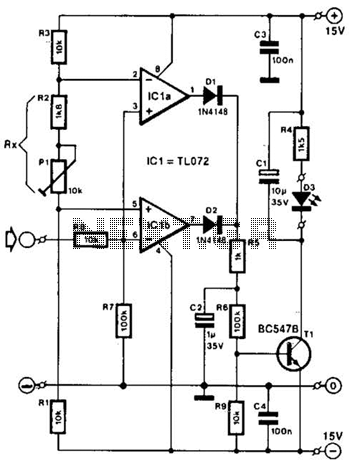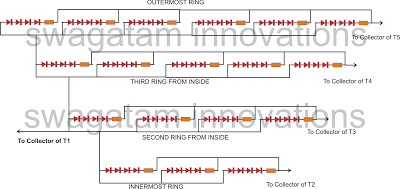
Overload Indicator Circuit

Two operational amplifiers are utilized as comparators to signal an excessive magnitude of an audio frequency (AF) signal, regardless of whether the signal is positive, negative, or asymmetrical. A reference voltage is established for both operational amplifiers using a potentiometer (PI). This circuit is particularly beneficial for audio amplifier applications and operational amplifier circuits that employ split power supplies.
The described circuit employs two operational amplifiers configured as voltage comparators, which are essential for monitoring the amplitude of audio frequency signals. Each op-amp is connected to a distinct input signal, allowing it to compare the incoming signal against a predefined reference voltage set by a potentiometer. This configuration enables the detection of both positive and negative signal peaks, providing a comprehensive assessment of the signal's magnitude.
In this setup, the reference voltage, adjusted through the potentiometer, allows for fine-tuning the threshold at which the comparators will trigger. When the AF signal exceeds this threshold, the output of the respective op-amp switches states, indicating that the signal has reached an excessive level. This functionality is critical in audio applications, where maintaining signal integrity is vital to prevent distortion or damage to downstream components.
The circuit is designed to operate effectively with split power supplies, which is common in audio amplifier designs. This allows the op-amps to handle both positive and negative signal swings, accommodating a wider range of audio signals. The ability to monitor asymmetrical signals further enhances the circuit's versatility, making it suitable for various audio processing tasks.
Overall, the use of two operational amplifiers as comparators in this circuit provides a robust solution for monitoring audio frequency signals, ensuring that excessive levels are detected and addressed promptly. This design is particularly relevant in environments where audio fidelity is paramount, and protection against signal overload is necessary. Two op amps are used as comparators to indicate excessive magnitude of an AF signal, either positive or negative, even if the signal is asymmetrical. PI sets the reference voltage for both op amps. This circuit is useful for audio-amplifier and op-amp circuits using split power supplies. 🔗 External reference
The described circuit employs two operational amplifiers configured as voltage comparators, which are essential for monitoring the amplitude of audio frequency signals. Each op-amp is connected to a distinct input signal, allowing it to compare the incoming signal against a predefined reference voltage set by a potentiometer. This configuration enables the detection of both positive and negative signal peaks, providing a comprehensive assessment of the signal's magnitude.
In this setup, the reference voltage, adjusted through the potentiometer, allows for fine-tuning the threshold at which the comparators will trigger. When the AF signal exceeds this threshold, the output of the respective op-amp switches states, indicating that the signal has reached an excessive level. This functionality is critical in audio applications, where maintaining signal integrity is vital to prevent distortion or damage to downstream components.
The circuit is designed to operate effectively with split power supplies, which is common in audio amplifier designs. This allows the op-amps to handle both positive and negative signal swings, accommodating a wider range of audio signals. The ability to monitor asymmetrical signals further enhances the circuit's versatility, making it suitable for various audio processing tasks.
Overall, the use of two operational amplifiers as comparators in this circuit provides a robust solution for monitoring audio frequency signals, ensuring that excessive levels are detected and addressed promptly. This design is particularly relevant in environments where audio fidelity is paramount, and protection against signal overload is necessary. Two op amps are used as comparators to indicate excessive magnitude of an AF signal, either positive or negative, even if the signal is asymmetrical. PI sets the reference voltage for both op amps. This circuit is useful for audio-amplifier and op-amp circuits using split power supplies. 🔗 External reference





